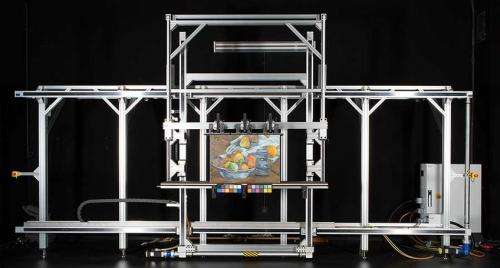New easel reveals secrets of old masters

A state-of-the-art easel is literally shedding new light on the ingenious variety of materials that have been used over the centuries to create artists' paint pigments.
The micro-positioning easel is giving scientists at The National Gallery, London, the ability to examine great works of art in unprecedented detail and is being used to analyse the paintings in a major new exhibition, Making Colour.
Funded through the support of the Engineering and Physical Sciences Research Council (EPSRC), the computer controlled easel is capable of safely holding a very large painting and moving it in minute steps to make the most of the latest digital technology. Identifying the materials used as pigments provides information on aspects such as the age of a picture and the painting technique used.
Scientists and other researchers at the National Gallery use digital imaging to build up a high resolution image of paintings to learn about their structure, the way they are made and what needs to be done for their preservation. The easel will open up opportunities to try out new types of research such as hypersepectral imaging.
Infrared imaging, X-ray imaging, electron microscopy and mass spectrometry are all used to discover more about the materials used by artists in the past and how they are likely to change over time.
Ashok Roy, the Director of Collections at the National Gallery, explains: We expect that we will be able to acquire very high resolution images in various parts of the spectrum that would be unobtainable without this technology, so it is a real advance in our imaging capabilities.
From ultramarine to regal gold and zinging silver, the National Gallery's new 'Making Colour' exhibition traces the history of how materials, natural and artificial, such as minerals and dyes were used to create colour in paintings from the Middle Ages to the end of the 19th century. Through a series of colour themed rooms visitors can experience how artists used colour and materials in their art.
Listen to an audio slide show with the conservation team at the National Gallery in our multimeda section, the title of the audio slideshow is the science of making colour.
Sassoferrato's Virgin in Prayer, one of the paintings in the exhibition, is painted in a rich deep royal blue. Joseph Padfield, conservation scientist at the National Gallery explains: Look at it from a distance and you might only see a single, strong blue, but if you're able to look at it much more closely you will see more subtlety to it. You will see the different brushstrokes that form the shadows and the highlights on the cloak and the details of how the fabric has been portrayed.
In the past the only way to really see this amount of detail is to take the painting down and look at it under a microscope, an option which is reserved for a very few people. Joseph explains how the easel could be used. If you're able to use equipment, like our new easel, to capture extremely high resolution images of a painting, then that special experience of beginning to explore how such a fabulous painting was created can be accessible to many more people.
The easel is also helping inspire a part of the 'Making Colour' exhibition. Visitors can get involved in an interactive experiment that will feed into future research on human colour perception. It involves capturing the responses of people as they view a picture under different conditions, using a tunable LED light source.
Philip Nelson, EPSRC's Chief Executive said: Many people see the Arts and Science as existing in isolation. This is far from the truth, scientific and engineering techniques can help us understand how great works were made, how they are perceived by the human brain and how they can be preserved for future generations to appreciate. EPSRC is proud to be working in partnership with the National Gallery both in the Making Colour Exhibition and on other projects.
The Making Colour Exhibition is on at the National Gallery until the 07 September 2014.


















